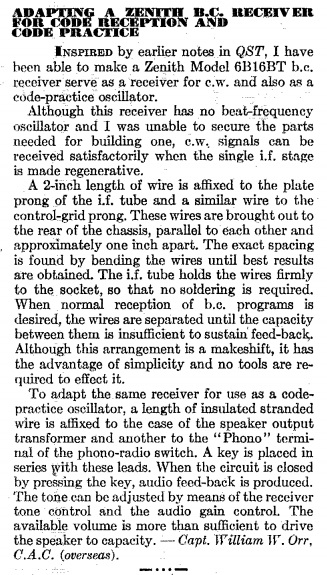
 Seventy five years ago, Capt. William W. Orr, stationed somewhere overseas with the U.S. Army Coast Artillery Corps, had a Zenith Model 6B16BT receiver similar or identical to the one shown above, but no way to listen to Morse Code transmissions with it. The set covered the standard broadcast band and 2.3 – 22 MHz shortwave, but the set was intended for listening to broadcast programs, and didn’t contain a Beat Frequency Oscillator (BFO) for listening to Morse Code. If there hadn’t been a war going on, adding a BFO would have been a relatively straightforward proposition of building a one-tube oscillator running near the set’s IF frequency of 455 kHz. But as Capt. Orr points out, he was “unable to secure the parts needed for building one.”
Seventy five years ago, Capt. William W. Orr, stationed somewhere overseas with the U.S. Army Coast Artillery Corps, had a Zenith Model 6B16BT receiver similar or identical to the one shown above, but no way to listen to Morse Code transmissions with it. The set covered the standard broadcast band and 2.3 – 22 MHz shortwave, but the set was intended for listening to broadcast programs, and didn’t contain a Beat Frequency Oscillator (BFO) for listening to Morse Code. If there hadn’t been a war going on, adding a BFO would have been a relatively straightforward proposition of building a one-tube oscillator running near the set’s IF frequency of 455 kHz. But as Capt. Orr points out, he was “unable to secure the parts needed for building one.”
Instead, he came up with a solution elegant in its simplicity. It is shown here from Hints & Kinks in the August 1944 issue of QST. He turned the IF into a regenerative stage by adding a “gimmick” capacitor to provide feedback. This consisted of nothing more than two short pieces of wire, sticking out the back of the set. It wasn’t even necessary to solder the wires. One was stuck into the socket for the plate pin, and the other one to the grid pin. To copy CW, the wires were moved close to one another. For listen to voice programs, the wires were moved apart.
Interestingly, the Knight Star Roamer receiver later used a similar method for copying CW. To copy CW, feedback was switched in to the IF stage to make it go into oscillation.
He used a similar trick to turn the set into a code practice oscillator. The key was hooked between the speaker transformer and the phono input. When the key was pressed, the resulting feedback could be used to generate the code.
I would like to thank Dave McClellan for providing the image of the beautifully restored Zenith receiver shown above. You can read about his restoration and see more pictures at this link.
